A typical problem in the bathrooms is high humidity levels, which can give rise to several issues, such as mold infestation, poor air quality, and even destruction of the walls, ceiling, and fixtures. A suitable answer to this problem may be using a dehumidifier within the bathroom and its setting. This paper will evaluate the advantages of using dehumidifiers in bathrooms, such as containing indoor pollution and structural damage, alongside guiding how to choose, place, and use these devices for maximum efficacy and sustainability. Knowing how a dehumidifier works in such an environment will aid you whether you are upgrading your system or addressing the persistent humidity problems to promote a healthier and more pleasant home.
Why Would You Need a Dehumidifier in the Bathroom?
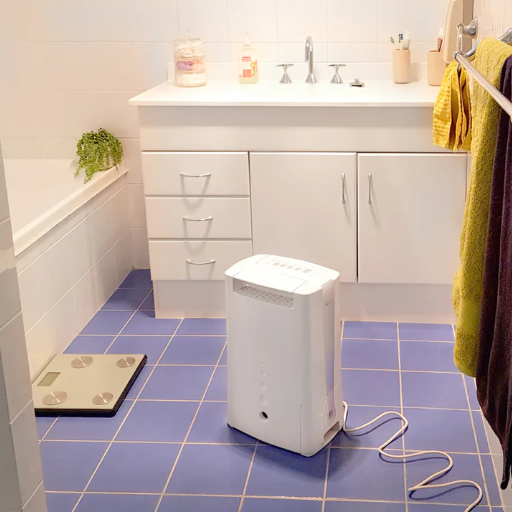
One of the common problems that bathrooms face is excess moisture caused by showers and baths, which release a considerable amount of steam. If not managed properly, this can result in mold and mildew growth or damage to the structure of walls, movers, ceilings, and other components. Damp air also obstructs indoor air quality, making indoor spaces prone to allergens and bacteria. A dehumidifier maintains moisture at optimal levels so that these problems do not arise by efficiently removing excess water vapor from the air. Doing so maintains an environment’s balance of health and comfort.
Understanding bathroom humidity levels
Bathroom humidity levels are usually between 40% and 60%; this range can increase with activities like taking hot showers. If optimal levels are not maintained, problems such as peeling paint, mold growth, and structural damage can become long-term. Prominent sources have done research illustrating the importance of having a proper ventilation system capable of removing excess moisture, such as using exhaust fans with proper CFM ratings. Adequate waterproofing and sealing of leaks within wet zones can prove helpful, too. When humidity is persistent, having a dehumidifier specifically designed for that size room is a good idea. Regular cleanliness and routine room monitoring with a hygrometer will ensure balanced humidity levels, making the bathroom a safer and healthier environment.
Risks of excess moisture in bathrooms
The growth of mold and mildew, along with other smells in a bathroom, is caused by high moisture levels within the bathroom. These problems raise a threat to one’s lungs as well. Moreover, exceeding humidity levels can also weaken the walls, ceilings, and floors of the building, which causes significant worry. Not normalizing dampness may also encourage the growth of bacteria and dust mites, adding to the hygiene issues. A way to resolve this issue is by planning proper ventilation, creating cleaning schedules, and putting dehumidifying devices in place.
Signs you need a dehumidifier in your bathroom
- Persistent Foggy Mirrors and Windows
If bathroom mirrors and windows remain fogged for an extended period after the shower, it indicates excessive humidity that isn’t dissipating effectively. This is a key signal that a dehumidifier may be required to manage moisture levels.
- Presence of Mold and Mildew
Mold or mildew on walls, tile grout, shower curtains, or ceilings is a visible sign of consistently high humidity. Mold growth damages surfaces and releases spores into the air, posing health risks.
- Peeling Paint or Wallpaper
Excessive moisture often causes peeling paint, bubbling wallpaper, or cracking finishes on bathroom walls. Such issues indicate that humidity levels are compromising structural materials.
- Musty Odors
A persistent damp or musty smell in your bathroom results from elevated moisture levels. This odor typically arises from mold, mildew, or moisture accumulating in areas with inadequate ventilation.
- Condensation on Bathroom Surfaces
Consistent condensation on walls, ceilings, or plumbing fixtures indicates that environmental humidity exceeds manageable levels. Without proper ventilation or dehumidification, this condensation can lead to long-term damage.
Installing a dehumidifier promptly can address these signs, enhance air quality, protect surfaces, and prevent the adverse effects of excess moisture in your bathroom.
How Does a Bathroom Dehumidifier Work?
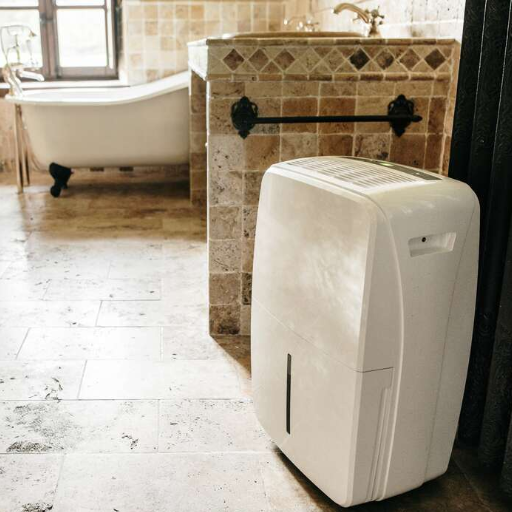
Exceeding moisture levels can be drawn out, making room for cleaner air with a bathroom dehumidifier. To keep humidity levels stable, the device can use a fan to take in the sticky air and then ventilate it through its cooled coils to condense the moisture, causing the air to be drier. While running through the coils, the moisture is transferred into droplets stored in a tank or released from an outlet. When the cooled air is released, the device changes the room by limiting condensation and the chances of mold growing. This further ensures that the bathroom’s air balance is healthy.
The science behind dehumidification
The dehumidification process relies on the concepts of thermodynamics and phase changes. The moist air is initially drawn into the dehumidifier and passed over the evaporator coils inside the dehumidifier unit. The temperature of these coils is maintained at a level lower than the dew point. This point is the temperature at which water vapor turns into liquid. When the moist air contacts these cooled coils, the water vapor condenses into droplets and separates from the air. The liquid is then collected in a funnel and transferred to the reservoir or drainage system inside the device.
Once the moisture has been removed, the drier air is reheated as it passes over the condenser coils inside the device and silenced back into the environment. The continuous cycle reduces relative humidity when the room is maintained at a specific temperature. Reducing the moisture in the room improves air quality, slows the growth of allergens such as mold and mildew, and prevents damage to materials sensitive to humidity.
Types of dehumidifiers suitable for bathrooms
The most commonly used types of bathroom dehumidifiers are desiccant, compressor, and thermo-electric, also called Peltier dehumidifiers. Chemical absorption and thermal dehumidification are used in desiccant models, making them extremely useful in poorly heated and cold bathrooms. For large bathrooms kept warm, compressor-based dehumidifiers work best as they efficiently extract outstanding amounts of moisture. Moderately humid conditions are most effective for thermo-electric dehumidifiers, which are compact and energy-saving, making them suitable for smaller bathrooms. It is good to remember that the correct type of dehumidifier depends on the size of the toilet and the humidity and temperature levels in the space.
Key features to look for in a bathroom dehumidifier
The most important factors are energy efficiency, capacity, and noise levels when choosing a dehumidifier for the bathroom. For more spacious washrooms, units that remove moisture more effectively, measured in pints per day, must be used, while less humid environments only require small and convenient models. Doing so eliminates long-term electricity costs, and Energy Star-certified designs are recommended. Noise levels are significant, too, and models with quieter operations are always preferred. Living spaces can be separated from bathing spaces to enhance comfort further. I emphasize features like auto-shutoff, adjustable humidistats, and easy maintenance, including removable, washable filters.
Can a Dehumidifier Replace a Bathroom Fan?
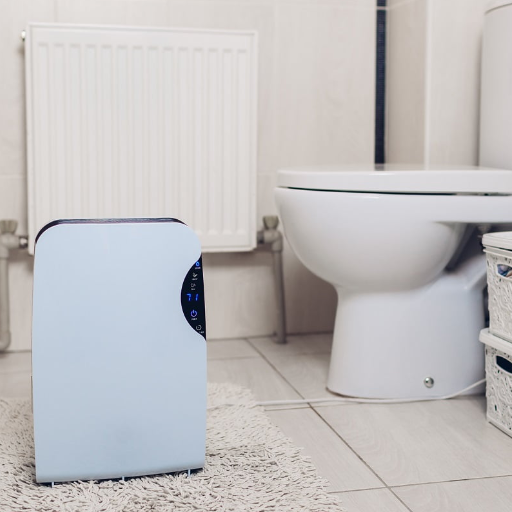
A dehumidifier is not adequate for ventilation since it only works to remove excess moisture within the bathroom. It cannot substitute for the function of a bathroom fan, which is needed to expel moist air and odor outside the bathroom. The dispelling of moist air aids in proper air circulation, reducing the chances of mold and mildew. In contrast, a dehumidifier can only draw moisture from the air without ventilation or air cleansing. Thus, a bathroom fan for proper ventilation and a dehumidifier for moisture control is recommended to achieve the most efficient results.
Comparing dehumidifiers and bathroom fans
Knowing the differences between dehumidifiers and bathroom fans is crucial, mainly regarding what they do and when to best use them. Bathroom fans, for instance, are designed to combat the humidity in the air by expelling it along with any odors outside. The sound quality of the air within the bathroom is preserved along with the moisture levels, excluding the possibility of mold and other issues. They do not function independently – a ventilation system is needed in conjunction with them. To maximize their effectiveness, bathroom fans should be operated during or after steam-generating activities such as showering.
Dehumidifiers are created to extract excess moisture from the air, collect it into a reservoir, and then drain it using a hose to reduce humidity levels indoors. These devices are handy in places with constant humidity issues; however, they do not provide ventilation or actively remove dirt particles from the air. While a bathroom fan tends to target immediate moisture problems, a dehumidifier caters to them in terms of long-term management of the humidity level. The best approach to eliminate moisture from a bathroom is to combine a bathroom fan with a dehumidifier.
Pros and cons of using a dehumidifier instead of a fan
Employing a dehumidifier rather than a fan has its pros and cons. A dehumidifier is excellent for long-term moisture user reduction, thus preventing mold and mildew spores from forming since it sucks in moisture from the air. This makes it exceptionally handy in bathrooms that do not have windows or proper ventilation, like exhaust fans. It also works well in continuously high-humidity areas. However, a downside is that it removes air without modeling airflow. This means rich trapping steam or noxious odors alongside alleviating smells. A fan, on the other hand, can relieve these issues. Moreover, there is a need for maintenance with a dehumidifier, including changing the filters and emptying the water tank. This maintenance helps dry up highly humid bathrooms. On the other hand, fans can work efficiently to improve air and save energy. In the end, the choice supply depends on the level of excess humidity there is and your specific requirements.
When to use both a dehumidifier and a fan
Combining a fan and dehumidifier works wonders when air circulation is crucial while dealing with high humidity. This combination is instrumental in basements, laundries, or even bathrooms where humidified air is left unattended, making these spaces prone to mold growth or damage. The fan increases air circulation, minimizing damp areas, while the dehumidifier counters by removing moisture from the air, keeping the levels around 30-50%. This combination effectively normalizes air in the short term while preventing long-term moisture problems. However, the fan must be positioned to rotate the air around the room and coupled with a dehumidifier to support the room’s needs.
What Are the Benefits of Using a Dehumidifier in the Bathroom?
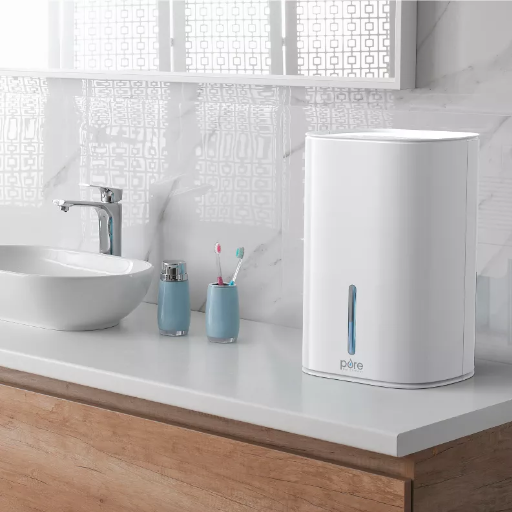
Employing a dehumidifier in the bathroom comes with many advantages. For one, it eliminates excess moisture, thus preventing the growth of mildew and mold, which is essential to protecting the well-being and beauty of the area. Moreover, such practices improve air quality as humidity is lowered. Dust mites and other allergens can barely survive under these conditions. This is beneficial for painting, grout, wood, and people in general. It is also worth noting that the reduction of humidity decreases odors and condensation on windows and mirrors, increasing the bathroom’s comfort and usability.
Preventing mold and mildew growth
To slow down the reproduction rate of mold and mildew, adequate ventilation, control humidity, and regular cleaning exercises are needed. Exhaust fans can improve air circulation and replacement within a building, removing the damp air and making conditions suitable for molds unfavorable. The relative humidity inside the house can also be lowered to 50% using dehumidifiers or air conditioning, thereby checking mold growth due to high moisture. Antifungal wipes, duster cloths, and weak detergents can be used routinely to clean surfaces, preventing the growth of mold spores. Furthermore, an antifungal surface coat can provide a clean base layer. Preventative maintenance coverage of areas most likely to sustain water damage, such as showers and sinks, is essential, but using a towel to dry them after use can also be helpful. By implementing these simple changes, mildew and mold find it far more challenging to grow, leading to improved cleanliness and air quality inside the building.
Reducing condensation on surfaces
To reduce surface condensation build-up, I concentrate on increasing ventilation, which can be exhaust fans for bathrooms and kitchens that let out damp air. Available towels and air dryers, or the most basic ones inside the HVAC units, can even be used to moderate the humidity in the room. It is also essential to maintain a set temperature inside the house so that warm, moist air does not come in contact with cold surfaces. Along with the rest, these steps prevent condensation build-up, all the associated dangers of mold, and even the destruction of structures.
Improving overall air quality
Improving indoor air quality requires various techniques to reduce pollutants and improve living conditions. Steps that can help achieve this include using HEPA filters within the HVAC systems to capture dust, allergens, and other small particles. Periodic filter cleaning and replacement will also increase the effectiveness of the system. The use of air purifiers can also help remove most contaminants like household VOCs. Good ventilation is equally essential for removing indoor pollutants like carbon dioxide and smells, as it pumps stale air out while fresh air comes in. Other strategies include the reduction of indoor pollution sources by avoiding smoking, selecting furniture that gives off low emissions, and cleaning using nontoxic substances. Also, humidity is monitored and kept between 30% and 50% to prevent the growth of mold and mildew that can lead to respiratory illnesses. When taken together, these measures lead to drastic changes in air quality and health improvement.
How to Properly Use a Dehumidifier in Your Bathroom?
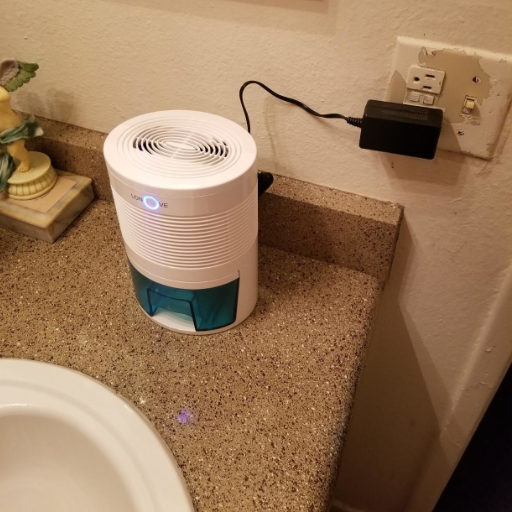
Choose one that best fits the room’s size and the average humidity level to use a dehumidifier efficiently in your bathroom. Ensure that the unit is situated on a plane surface and has plenty of space clearance from the furniture and walls so as not to obstruct the proper air circulation. Make sure to turn on the dehumidifier right after every shower or bath to eliminate any residual moisture in the air quickly. Always clean and empty the water collection tank after every use to stop any bacteria from forming, and clean the filter now and then as well, but replace it whenever the manufacturer suggests. Set the humidity level of your bathroom, with the help of the dehumidifier, to the most effective level of 30 to 50 percent, and it will do the rest. If the unit has a hygrometer fit in its system, then there will not be much else to worry about.
Optimal placement of the dehumidifier
For a dehumidifier to fully function as intended, proper placement is essential. Adjust the dehumidifier so that it is further away from areas considered dry. The unit must also be flat over 6 inches from walls, furniture, or other items. Placing the device in these positions allows for optimal air circulation. Curtain and furniture placement should also be considered because they obstruct proper air circulation. If the bathroom is without windows, dehumidifiers go near windows to compensate. Dehumidifiers must also be placed next to an outlet to be powered and close to hose drains for ease of use. Position the unit with a clear view of the area where the hose is placed to be more efficient. Set the dehumidifier on an elevated surface, allowing the device to view the surrounding area. Environmental changes could affect a dehumidifier’s performance, so regular assessments should be done for it to work correctly.
Setting the proper humidity levels
I suggest maintaining a relative humidity between 30 and 50 percent for most indoor environments. This range is ideal as it minimizes moisture content that could trigger an irritation while also preventing humidity levels that could serve as a breeding zone for mold and dust mites. It is best to keep humidity at around 30 to 40 percent during cold seasons. This reduces the chances of condensation on windows. During the warm season, 50 % is a better target. To achieve the preferred ranges, the built-in hygrometer available in the d humidifier may be used as well as an external device. Due to seasonal or specific room changes, maintenance must be performed to ensure accurate levels.
Maintenance tips for bathroom dehumidifiers
Even the best dehumidifiers for bathrooms require maintenance to operate at their best. As the manufacturer recommends, start cleaning the filter every 2- 4 weeks. If this is not handled, dust, mold spores, and debris could build up in the filter, reducing effectiveness. To minimize the chances of spilling, the water tank needs to be emptied as best as possible. Moreover, check the hose frequently for any kinks and clogs on the humidifier to ensure efficient continuous drainage.
Also, wipe clean the exterior and interior components with a soft cloth wet with water and a minor quantity of detergent to control soap scum or mildew that often occurs in high-humidity locales such as bathrooms. Ensure no obstructions exist in the fans and vents so air can flow freely. Occasionally, a hygrometer tests the humidity sensor to ensure it gives the correct readings and that the dehumidifier settings are correctly set. For the units with the refrigerant systems, check the coils for any frost or residue build-up and clean them if necessary.
Are There Any Drawbacks to Using a Dehumidifier in the Bathroom?
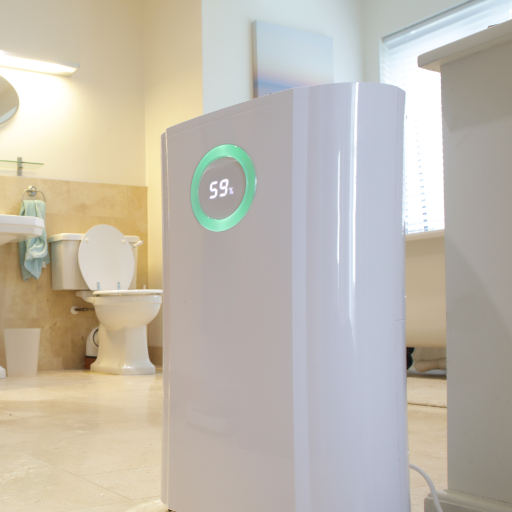
Although dehumidifiers effectively manage bathroom humidity, their use poses some problems. Dehumidifiers are often noisy, and the noise can be irritating in small, confined spaces like bathrooms. Moreover, cleaning the water tank and the filters is routine when washing the dehumidifiers. Furthermore, overusing electricity can be a significant issue, as it causes spikes in the electric bill. Lastly, small and portable units can’t be used in big bathrooms because they perform poorly in high humidity and poor ventilation.
Energy consumption concerns
Because dehumidifiers run on electric motors, they consume much energy, increasing utility bills. The power consumed is relative to the unit’s capacity, energy efficiency ratio, and usage frequency. Newer versions of these machines use less energy than conventional models. It’s best to switch off the dehumidifier when not in use, to set it according to the required humidity, and to buy energy-efficient versions of these machines to keep the costs low. Routine maintenance, such as filter cleaning and emptying, can improve efficiency and lower energy consumption.
Noise levels and disturbances
The sound produced during the operation of the dehumidifiers differs from one model to the other and from one size to the other, with smaller models generating humming sounds. In contrast, the more sophisticated ones make louder noises when integrated with a powerful compressor and fan system. Most contemporary models are integrated with noise-dampening technology, which can efficiently reduce the noise produced during work. There are models of dehumidifiers that can operate at a lower volume and be a good option for those sensitive to sound. It is also appropriate to look at the specifications provided and check the decibel figure as well to be on the safe side.
Potential water damage risks
Improper management of a dehumidifier or neglect of its maintenance may cause water damage issues within your premises. If the water collection tank is not frequently emptied or the drain hose or pump mechanism is faulty, leakage or overflowing may occur. Eventually, pollution of filters may lead to restriction of airflow and condensation build-up, which may ooze to other surfaces. Adhering to the manufacturer’s maintenance recommendations for unit cleansing and drainage system checks is very important. Aside from those, the dehumidifier should be put on a flat surface to block any chances of spilling and, further, spaced from walls or furniture to block any moisture from forming on the materials nearby. Unplanned damage may emerge due to improper service and maintenance of the instruments.
What Are Some Alternatives to Using a Dehumidifier in the Bathroom?
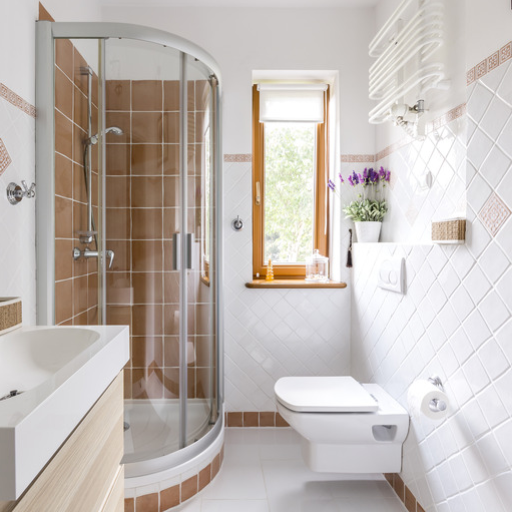
On the other hand, a dehumidifier is not the only way to lower the humidity levels in the bathrooms; other options can also be used with relative success. For example, installing a high-volume exhaust fan can be very useful since it eliminates humid air during the shower and even afterward. One can open windows or use a window fan, which will also help to minimize moisture buildup since they enhance airing and circulation. Moreover, applying a waterproof sealant on the walls and grout can reduce the amount of moisture absorbed and thus inhibit mold proliferation. Silica gel packs and even calcium chloride can be used on a smaller scale as they absorb moisture. Most importantly, normal humidity should be maintained through adequate insulation and the fixing of plumbing leaks if they exist.
Improving natural ventilation
Enhancing natural ventilation in a bathroom requires simple strategies to reduce hot air moisture. One way to exchange humid indoor air after a shower with drier outdoor air is by opening windows. This process can be improved by setting windows on opposing sides of the space or using both windows and a fan. Furthermore, installing vented skylights is an excellent addition to traditional bathroom windows with fewer wall openings. Plants such as ferns, which do well in humid areas, can be placed in targeted locations to help absorb moisture naturally. By merging all these methods, the bathroom can be made nonhumid, improving air quality while preventing damage and mold formation.
Using moisture absorbers and desiccants
To regulate the humidity in the bathroom, moisture removers, and desiccants work well. I suggest using silica gel packets, activated charcoal products, or other calcium chloride-based materials due to their effectiveness in sucking moisture from the air. Place these dehumidifiers in the corners, on the shelves, or any place where humidity is a problem. Reusable ‘rechargeable’ desiccants are the best for an even more environmentally friendly option. These options significantly decrease the humidity levels while reducing condensation and preventing mold growth – ensuring the bathroom is dry and clean over the long term.
Implementing proper shower habits
Good shower etiquette focuses on responsibility for one’s plumbing and skin. Dermatologists and environmentalists advise that most individuals shower at least once daily for a few days a week. This is reliant on skin type and levels of activity. Showering more frequently, especially with hot water, can cause the skin to lose beneficial oils, leading to irritating and dry skin.
Limit your showers to a lukewarm 5-10 minutes to achieve the best results, and use fragrance-free gentle cleansers. Skin barriers are meant to be preserved. Pay attention to key areas like armpits, groin, and feet and scrub them without traumatizing the skin. Most people only need to wash their hair 2-3 times per week, although this figure may change depending on their oil production and hair type.
Using low-flow showerheads is a good way to conserve water, and people are encouraged to minimize their water usage and environmental impact. A person’s hygiene, skin, and environment can be sufficiently maintained by doing all these actions.
References
Frequently Asked Questions (FAQ)
Q: Why should I put a dehumidifier in my bathroom?
A: Putting a dehumidifier in your bathroom helps remove excess moisture from the air, preventing mold growth, reducing humidity levels, and improving overall air quality. This is especially beneficial in damp bathrooms or areas with poor ventilation, as it helps protect the integrity of your bathroom and prevents water damage to walls and fixtures.
Q: Can I use a dehumidifier instead of a bathroom fan?
A: While using a dehumidifier instead of a bathroom fan is possible, it’s not always the best solution. A dehumidifier can effectively remove moisture from the air, but an exhaust fan also helps remove odors and steam more quickly. Ideally, use both appliances for optimal results, especially in a small bathroom with high humidity.
Q: How do I choose the right dehumidifier for my bathroom?
A: When selecting dehumidifiers for bathrooms, consider the size of your bathroom, the humidity levels, and the appliance’s capacity. Look for a model with a built-in humidistat to monitor and control humidity levels automatically. A compact, portable dehumidifier for small bathrooms may suffice, while larger bathrooms might require a more powerful unit.
Q: Should I open the window in the bathroom using a dehumidifier?
A: It’s generally not recommended to open the window while you’re using a dehumidifier in the bathroom. Open windows allow humid outside air to enter, making the dehumidifier work harder. However, if you’re not using the dehumidifier, opening the window can help ventilate the space and reduce moisture naturally, especially after showering and bathing.
Q: How often should I run a dehumidifier in my bathroom?
A: The frequency of running your dehumidifier depends on your bathroom’s humidity levels and usage. Running the dehumidifier for a few hours after each shower or bath is beneficial to remove excess moisture. Some people run it continuously in particularly damp bathrooms or humid climates. The humidistat maintains optimal humidity levels between 30% and 50%.
Q: Can a dehumidifier replace an extractor fan in the bathroom?
A: While a dehumidifier can help remove moisture from the air, it’s not a direct replacement for an extractor fan. An extractor fan is designed to quickly remove steam and odors from the bathroom, whereas a dehumidifier works more slowly to reduce overall humidity. Use both appliances in tandem for best results, especially in areas like the bathroom, where moisture levels can rise quickly.
Q: How do I maintain my bathroom dehumidifier?
A: To keep your bathroom dehumidifier functioning effectively, empty the water tank regularly, clean the air filter monthly, and wipe down the exterior to prevent dust buildup. Keep the unit away from walls and water sources to ensure proper airflow. Check the dehumidifier’s manual for specific maintenance instructions, as requirements may vary between models.
Q: Is leaving a dehumidifier in the bathroom safe when I’m not home?
A: Most modern dehumidifiers are safe to leave running when you’re not home, provided they’re properly maintained and placed on a level surface away from water sources. Many units have an auto-shutoff feature when the water tank is full. However, for added safety, consider using a dehumidifier with a continuous drain option or setting it to run on a timer when you’re away for extended periods.



